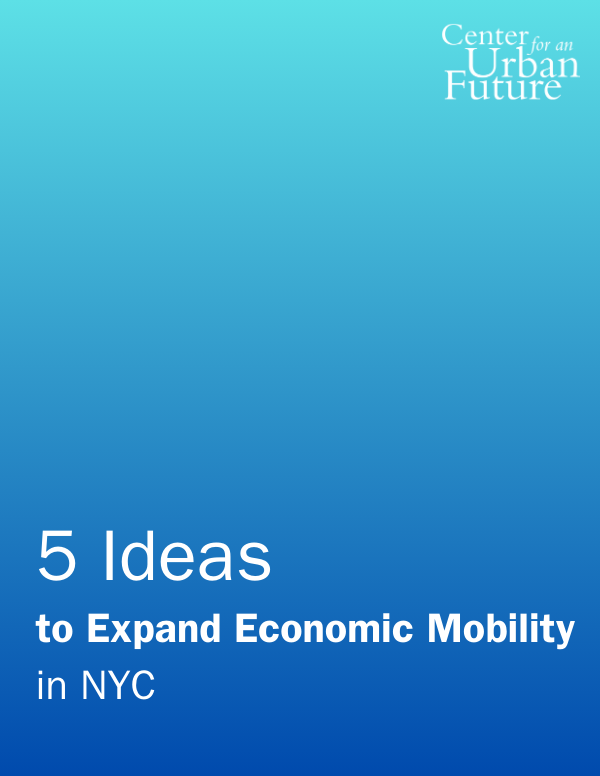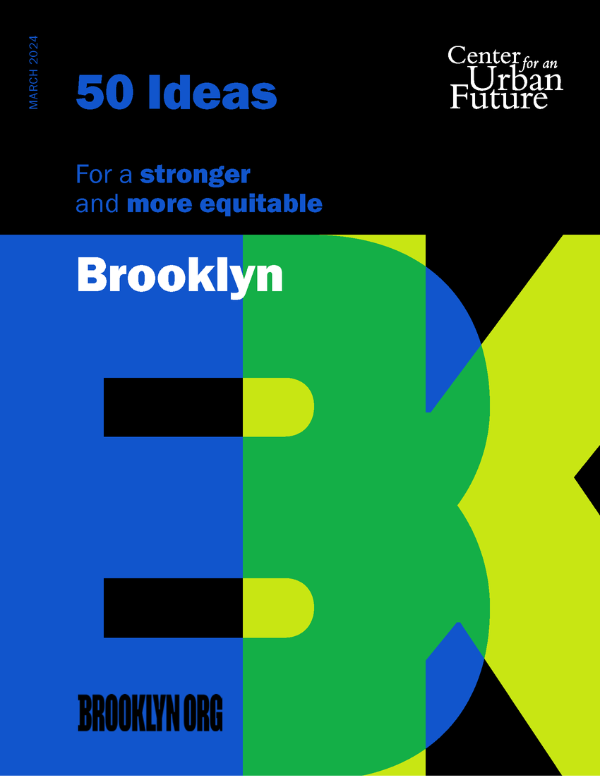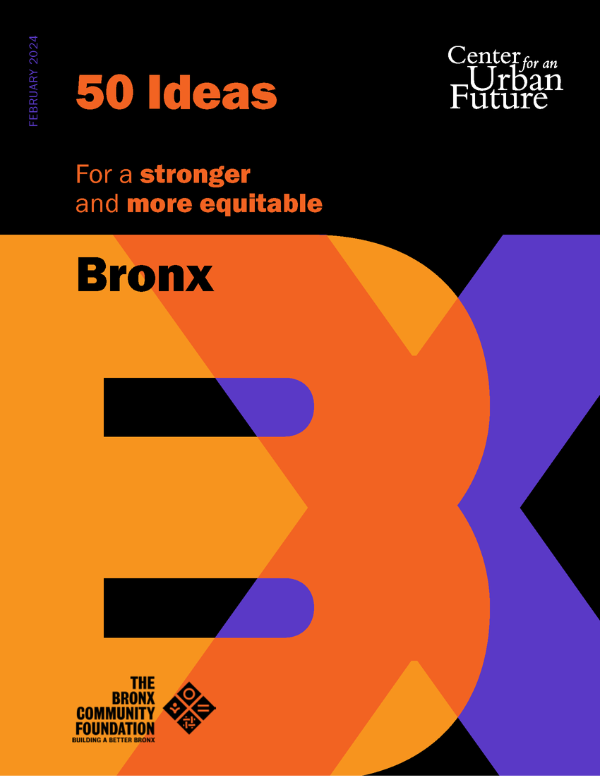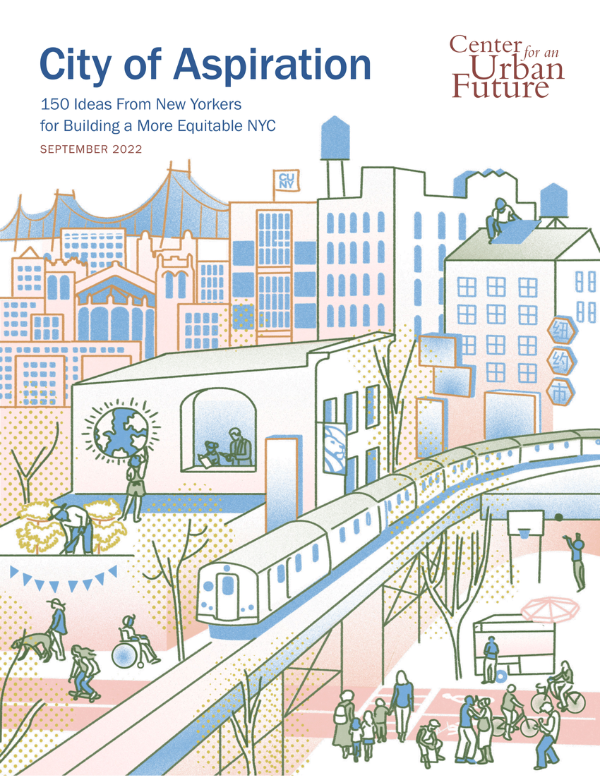- The following is the introduction and full list of ideas from 50 Ideas for a Stronger and More Equitable Queens.
- Click here to explore the full report and read all of the practical and visionary ideas contributed by 50 Queens leaders.
If New York City is going to succeed in creating a more equitable economy, Queens will almost certainly need to play a starring role.
Queens is New York’s borough of opportunity. Home to more than one million immigrants, Queens is the city’s largest gateway for newcomers seeking a better life. It is also arguably New York’s most important launchpad to the middle class, where so many working adults—from nurses to municipal employees—purchase their first home and where countless entrepreneurs from modest backgrounds pursue the American Dream.
Today, Queens has the lowest unemployment rate of any borough, backed by an economy that benefits from an incredible diversity of industries and job centers, including hospitals, airports, educational services, wholesale and retail trade, and film and TV production. It boasts an array of bustling commercial districts, from Flushing and Jackson Heights to Richmond Hill, Jamaica, and Corona.
The borough also benefits from emerging opportunities that play to Queens’s strengths. The new reality of hybrid work is strengthening neighborhoods across the borough, as residents spend more weekdays closer to home, and new investments in housing and infrastructure are helping Queens shape the city’s future.
But despite all that Queens has going for it today, policymakers still have significant work to do to capitalize on the borough’s many opportunities and to ensure that more of its residents are able to participate in its growing prosperity. Queens also faces a number of significant challenges that local leaders and city officials will need to address in the months and years ahead.
Skyrocketing rents and home prices are pushing many middle class residents to flee the borough, including a growing number of Black homeowners from southeastern Queens—dealing a blow to one of the borough's greatest strengths. Queens is uniquely exposed to the risks of climate change, due to the borough’s 113 miles of coastline and inadequate sewer infrastructure in many neighborhoods. Queens is home to more older adults—403,000 residents ages 65 and older—than any other county in the state, many of whom are struggling with housing affordability, financial security, and social isolation. Of all the boroughs, Queens also has the highest share of residents without health insurance, and the second-lowest college attainment rate.
Transportation options are limited in large swaths of the borough, leaving residents with some of the longest commutes in the city. And despite a strong overall economy, Queens lags behind Manhattan and Brooklyn in becoming a hub for jobs in the fast-growing tech sector. The borough will also need considerably more help in absorbing and integrating the newest New Yorkers; it is currently home to more migrants—and more undocumented immigrants overall—than any other borough.
There is already broad agreement among local leaders that addressing the borough’s biggest challenges, taking advantage of its many opportunities, and laying the foundation for a stronger and more equitable borough will require bold action and forward-thinking ideas. However, there is much less understanding of what specific steps should be taken. This report aims to fill that gap.
The report—the third in a series by the Center for an Urban Future that sets forth concrete ideas for bolstering each of the five boroughs—presents 50 bold policy ideas for what Mayor Adams, the City Council, Queens Borough President Richards, and other city leaders can do to create a stronger, more equitable Queens.
The 50 ideas in this report—a joint project between the Center for an Urban Future and the Queens-based Elmezzi Foundation—all emanate from leaders across Queens. To generate fresh and achievable ideas, we turned to a diverse mix of 50 exceptional Queens leaders. Those contributing an idea to the report include community advocates, heads of social service nonprofits, business owners, educators, urban planners, artists, faith leaders, and more. We asked each of them to contribute a single policy idea that would help more Queens residents get on the path to the middle class, strengthen social infrastructure, address the affordability crisis, close racial and ethnic opportunity gaps, improve health outcomes, and bolster neighborhoods across the borough. This report contains ideas both practical and visionary.
50 Ideas for a Stronger and More Equitable Queens
1. Host “Celebrate Queens” events to draw visitors to the borough’s unique businesses and cultural venues
Yanki Tshering, Founder and Executive Director, Accompany Capital
2. Pilot a massive summer school program in Queens to help students catch up from pandemic learning loss
Kenneth Adams, President, LaGuardia Community College
3. Create new affordable housing in Queens for public servants, nonprofit workers, and other middle income New Yorkers who work in fields that provide a public service
Rev. Patrick O’Connor, Lead Pastor, First Presbyterian Church in Jamaica, and Co-Chair, Queens Power
4. Establish an Institute for the Study of Hate and Solutions in Queens
Frank H. Wu, President, Queens College
5. Extend ferry service to Willets Point and LaGuardia Airport
Tina Lee, President of Cooper Investors Inc., and Co-Chair of the Downtown Flushing Transit Hub Business Improvement District
6. Appoint a migrant population czar of Queens
Cameron R. Hernandez, Executive Director and Chief Operating Officer, Mount Sinai Queens
7. Establish the first-ever Queens Community Foundation
Seth Bornstein, Executive Director, Queens Economic Development Corporation
8. Help Queens attract and retain more young professionals by establishing new 24-hour communities in parts of the borough
Melva M. Miller, President, Melva M. Miller & Associates, Inc. and Former CEO, Association for a Better New York (ABNY)
9. Open an aquatic center in the Rockaways
Ebony Beaty, Executive Director, Ocean Bay CDC
10. Institute an arts and culture tax on new developments in Queens
Sally Tallant, President and Executive Director, Queens Museum
11. Create a toolkit that makes it easier for Queens homeowners to make major repairs and upgrades
Arthi Krishnamoorthy, Senior Principal, TenBerke Architects
12. Offer education at every food pantry
Pedro Rodriguez, Executive Director, La Jornada
13. Create a fund for community-based outpatient mental health clinics that serve low-income immigrants including those without insurance
Myoungmi Kim, President & CEO, Korean Community Services
14. Help churches and other religious institutions build affordable housing on unused land
Ben Thomases, Executive Director, Queens Community House
15. Create a comprehensive broadband subsidy and support program to close the digital divide in Queens
Dawn Charles, Founder, Flvsh
16. Strengthen the Design and Construction Excellence program to bolster Queens’ architectural portfolio
Everardo Jefferson, Principal and Founder, Caples Jefferson Architects PC
17. Prepare Queens youth for the green jobs of the future
Dennis Walcott, President and CEO, Queens Public Library
18. Triple the size of the team dedicated to restoring the city's wetlands
Terri Carta, Executive Director, Jamaica Bay-Rockaway Parks Conservancy
19. Upzone commercial areas of Southeast Queens as a part of the “City of Yes” to build the affordable housing needed to keep Black residents from leaving the borough
Pastor Robert Lowe, Mount Moriah AME Church
20. Create a Queens Learning Network and innovation fund to address inequities in Queens
Anthony Negron, Director of Digital Programming, New York Hall of Science
21. Incentivize the construction of accessory dwelling units in Eastern Queens
Rafael Herrin-Ferri, Author, All the Queens Houses
22. Pursue new and scale up existing methods of revenue generation to support Flushing Meadows Corona Park
Jean Silva, President, Flushing Meadows Corona Park Conservancy
23. Build partnerships with ethnic food vendors to offer culturally preferred food at food pantries and in food service programs
Mary Archana Fernandez, Director of Family Support Services, South Asian Council for Social Services
24. Incentivize tech businesses to come to Queens to develop the borough as a tech center
Thomas Grech, President and CEO, Queens Chamber of Commerce
25. Plant more street trees along Jamaica Avenue
Kelsey Brow, Executive Director, King Manor Museum
26. Improve sewage infrastructure in Long Island City
Laura Rothrock, President, Long Island City Partnership
27. Pilot floating housing and raise roads in the Rockaways
Jeanne DuPont, Executive Director, RISE (Rockaway Initiative for Sustainability & Equity)
28. Create a cultural heritage district designation
Xenia Diente and Jaclyn Reyes, Co-Founders, Little Manila Queens Bayanihan Arts
29. Place Queens-based navigators in communities to help people navigate social services
Elizabeth McNierney, Director of Programs, ACE Programs
30. Invite health professionals into Queens high schools to help more young people get interested in pursuing medical careers
Lorraine Chambers Lewis, Executive Director, Long Island Jewish Forest Hills Hospital
31. Commit to a significant increase in the production of senior housing in Queens, and accelerate the process so new housing can be developed faster
Stacy Bliagos, Executive Director, HANAC
32. Guarantee that 40-50 percent of contracts for infrastructure projects go to minority and women-owned businesses
Justin Rodgers, President and CEO, Greater Jamaica Development Corporation
33. Create menstrual leave for people with gynecological conditions
Michelle Ng, Founder, Neuemoon Health
34. Provide new resources that enable ESOL providers to expand contextualized job training programs in higher-wage fields
Judy Zangwill, Executive Director, and Johan Lopez, Director of Adult and Immigrant Services, Sunnyside Community Services
35. Create a 10-year vision for Flushing Meadows Corona Park
John Wang, Founder, Queens Night Market
36. Open a multicultural community center focused on bringing together the borough’s different ethnic communities
Dr. Uma Mysorekar, President, Hindu Temple Society
37. Keep older adults in their longtime neighborhoods by building new affordable housing with built-in social services
Stuart C. Kaplan, CEO, Selfhelp Community Services
38. Expand direct cash support to provide relief for families in need
William Weisberg, CEO, Forestdale Inc.
39. Bolster vocational programs by better marketing them to high school students and by offering tax incentives to entice more employers to participate
Danielle Ellman, CEO, Commonpoint Queens
40. Use artificial intelligence to improve college access and relieve strain on guidance counselors of AI models for college access
Cielo Villa, Founder and CEO, Road to Uni
41. Provide vouchers for shelter residents to purchase meals from local restaurants
Jonathan Forgash, Executive Director, Queens Together
42. Purchase buildings for small to mid-size nonprofits
Nat Roe, Executive Director, Flux Factory
43. Shelter undocumented immigrants by expanding CityFHEPS eligibility
Theo Oshiro, Co-Executive Director, Make the Road New York
44. Create a livable checklist to guarantee that key amenities exist in every neighborhood
Sheila Lewandowski, Co-Founder and Executive Director, The Chocolate Factory Theater
45. Create “safety dojos” or conflict resolution centers in public schools
Rana Abdelhamid, Founder and Executive Director, Malikah
46. Create green job pipelines for immigrants in Queens
Nilbia Coyote, Executive Director, New Immigrant Community Empowerment (NICE)
47. Celebrate the QueensWay through a new communication campaign
Andrea Crawford, Esq., CPHRM, Friends of the QueensWay
48. Create a new housing subsidy program and take other action to address the affordable housing crisis for Queens older adults
William Jourdain, Executive Director, Woodside on the Move
49. Require that all new development projects invest in local arts and culture
Karesia Batan, Founding Executive Director, Queensboro Dance Festival
50. Implement a Successor to 421A
Hal Rosenbluth, President, Kaufman Astoria Studios, and Tracy Capune







